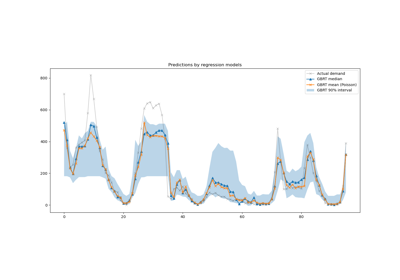mean_absolute_percentage_error#
- sklearn.metrics.mean_absolute_percentage_error(y_true, y_pred, *, sample_weight=None, multioutput='uniform_average')[source]#
Mean absolute percentage error (MAPE) regression loss.
Note that we are not using the common “percentage” definition: the percentage in the range [0, 100] is converted to a relative value in the range [0, 1] by dividing by 100. Thus, an error of 200% corresponds to a relative error of 2.
Read more in the User Guide.
Added in version 0.24.
- Parameters:
- y_truearray-like of shape (n_samples,) or (n_samples, n_outputs)
Ground truth (correct) target values.
- y_predarray-like of shape (n_samples,) or (n_samples, n_outputs)
Estimated target values.
- sample_weightarray-like of shape (n_samples,), default=None
Sample weights.
- multioutput{‘raw_values’, ‘uniform_average’} or array-like
Defines aggregating of multiple output values. Array-like value defines weights used to average errors. If input is list then the shape must be (n_outputs,).
- ‘raw_values’ :
Returns a full set of errors in case of multioutput input.
- ‘uniform_average’ :
Errors of all outputs are averaged with uniform weight.
- Returns:
- lossfloat or ndarray of floats
If multioutput is ‘raw_values’, then mean absolute percentage error is returned for each output separately. If multioutput is ‘uniform_average’ or an ndarray of weights, then the weighted average of all output errors is returned.
MAPE output is non-negative floating point. The best value is 0.0. But note that bad predictions can lead to arbitrarily large MAPE values, especially if some
y_truevalues are very close to zero. Note that we return a large value instead ofinfwheny_trueis zero.
Examples
>>> from sklearn.metrics import mean_absolute_percentage_error >>> y_true = [3, -0.5, 2, 7] >>> y_pred = [2.5, 0.0, 2, 8] >>> mean_absolute_percentage_error(y_true, y_pred) 0.3273... >>> y_true = [[0.5, 1], [-1, 1], [7, -6]] >>> y_pred = [[0, 2], [-1, 2], [8, -5]] >>> mean_absolute_percentage_error(y_true, y_pred) 0.5515... >>> mean_absolute_percentage_error(y_true, y_pred, multioutput=[0.3, 0.7]) 0.6198... >>> # the value when some element of the y_true is zero is arbitrarily high because >>> # of the division by epsilon >>> y_true = [1., 0., 2.4, 7.] >>> y_pred = [1.2, 0.1, 2.4, 8.] >>> mean_absolute_percentage_error(y_true, y_pred) 112589990684262.48
